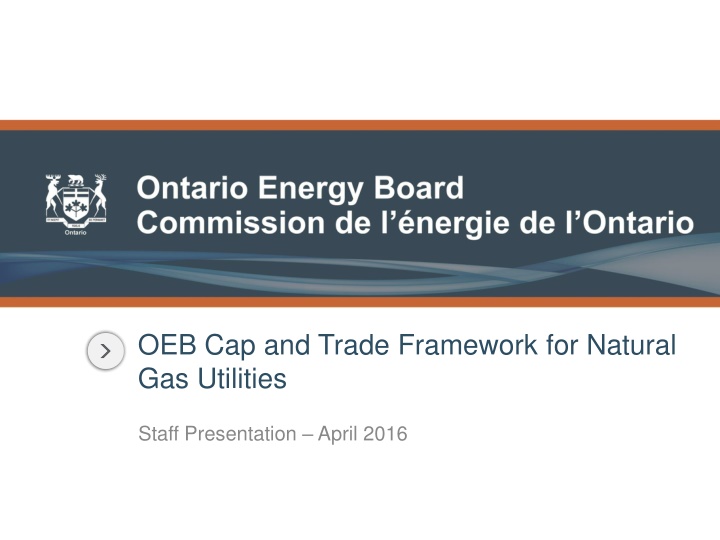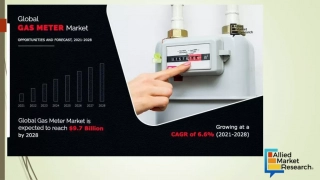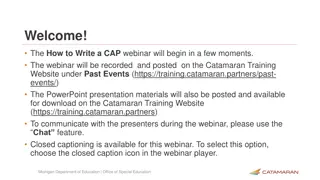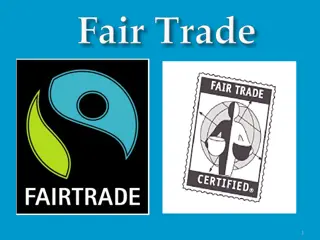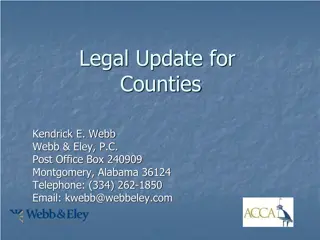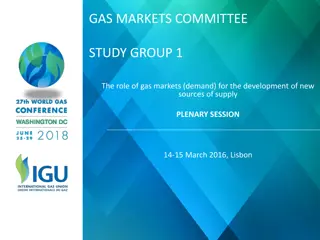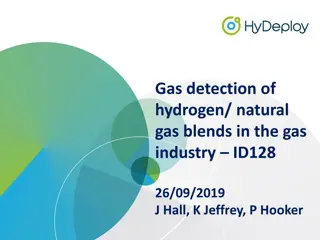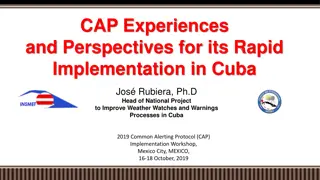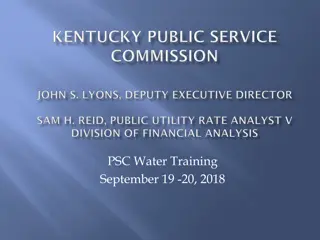OEB Cap and Trade Framework for Natural Gas Utilities
This presentation discusses the draft framework based on the provincial government's Proposed Climate Change Mitigation and Low-Carbon Economy Act, 2016, to support the successful implementation of the cap and trade program for natural gas utilities. It aims to establish clear expectations, assess cost consequences, and ensure cost recovery mechanisms. The framework prioritizes cost-effectiveness, rate predictability, and transparency.
Download Presentation

Please find below an Image/Link to download the presentation.
The content on the website is provided AS IS for your information and personal use only. It may not be sold, licensed, or shared on other websites without obtaining consent from the author.If you encounter any issues during the download, it is possible that the publisher has removed the file from their server.
You are allowed to download the files provided on this website for personal or commercial use, subject to the condition that they are used lawfully. All files are the property of their respective owners.
The content on the website is provided AS IS for your information and personal use only. It may not be sold, licensed, or shared on other websites without obtaining consent from the author.
E N D
Presentation Transcript
OEB Cap and Trade Framework for Natural Gas Utilities Staff Presentation April 2016
Outline of Presentation Purpose of Today Background Context for draft Framework Purpose of Framework Objectives of Framework Draft Regulatory Framework Elements Issues and Options Timing
Purpose of Today Seek stakeholder views on: Key Elements of the Framework - Issues and Options Any other issues? Views will support the development of Staff Discussion Paper on the Regulatory Framework
Background: Context for draft Framework Draft framework is based on provincial government s Proposed Climate Change Mitigation and Low-Carbon Economy Act, 2016 (Bill 172), The Cap and Trade Program dated February 25, 2016
Background: Purpose of Framework The purpose of the framework is: To support the successful implementation of the government s cap and trade program and utility compliance plans To ensure clear and consistent expectations are held by natural gas utilities, ratepayers and other stakeholders To provide OEB s approach to assessing the cost consequences of natural gas utility compliance plans and establishing a mechanism for recovery of these costs in rates
Background: Objectives of Framework The framework will be guided by the following objectives: Cost-effectiveness: compliance plans are optimized for economic efficiency and risk management, and investment decisions are prioritized and paced to ensure just and reasonable rates consistent with the government s cap and trade program Rate predictability: consumers should have reasonable, predictable rates regarding the impact of the utilities cap and trade activities Cost Recovery: prudently incurred costs related to cap and trade would be recoverable as a cost pass-through (similar to natural gas supply procurement)
Background: Objectives of Framework (contd) Transparency: investment/procurement strategies, and optimization processes are transparent and well documented to facilitate the OEB s assessment of the plans and costs, while ensuring market integrity Flexibility: plans are flexible and can adapt to changing market conditions and utility-specific characteristics; potential for framework to evolve as market matures and experience is gained Continuous Improvement: plans demonstrate continuous improvement of processes and practices, including the use of existing systems
Draft Regulatory Framework Elements 1. Compliance Plans 2. Modeling and Forecasting 3. Cost Allocation and Rate Design 4. Monitoring and Reporting 5. Customer Outreach and Education
1. Compliance Plans Utility-specific plans developed and attributed to the utility based on guidance from the OEB These plans will meet: Customer-related obligations, which include compliance and procurement for residential, commercial and industrial customers (excluding Large Final Emitters [LFEs]), and natural gas-fired generators Facility-related obligations, which include compliance and procurement obligations for utility s owned or operated facilities
1. Compliance Plans Plans could include provisions for: Compliance Instruments (see slide 11) Investments for customer-related obligations: o Customer abatement programs o Renewable energy, new technology, building retrofits, etc. Investments for facility-related obligations: o Measures to mitigate and reduce fugitive emissions o Investments in new technology o Renewable energy, building retrofits, etc.
1. Compliance Plans Compliance Instruments Risk Level Instrument Market Definition Real and verifiable allowances available during government administered auctions. Clearing price risk in competitive auction with some predictability Auction Allowances Primary M Negotiated price for government sourced allowances between counterparties, improves price certainty, higher availability risk Allowance Bi-laterals Secondary L Standardized futures contract traded on an exchange by a broker with delivery dates, volume and spec. terms and margin call requirements Allowance Futures Primary M Customized contract traded over the counter (OTC) that includes both market and credit risk Allowance Forwards Secondary M Compliance-grade instrument generated by emission reduction activities outside of covered emissions scope. Must be quantified and verified, leading to performance, credit and market risks Offsets Secondary L Offsets Futures Primary H Exchange traded futures contracts for verified offsets Allowance derivative products offering the right to buy or sell an allowance for a set price during a future period (options) and swaps Allowance Derivatives Tertiary H
1. Compliance Plans Issues and Options Issues Options A systematic approach to pacing and prioritization in the short and long term A buying strategy that demonstrates a balanced portfolio of compliance instruments Forecasts (of load, greenhouse gas (GHG) and carbon prices) Risk assessment (identification of key risks [e.g., forecasting risks, market risks] and how these risks will be mitigated) Cost assessment o Marginal abatement cost curve (MACC) o Costs per tonne (CAD $/tonne) per compliance activity o ICE (carbon price benchmark) o Compare costs of investing in GHG abatement activities with cost of allowances and offsets o Financing costs over the compliance period Assessment of Plans OEB requires that the utility have a portfolio of compliance instruments to ensure cost-effective plans and rate predictability. Utility decides on how best to develop its portfolio and participate in the market Compliance Strategy Prescription/ Guidance Level OEB sets minimum auction purchases (e.g., a certain percentage per year) OEB sets limitations on certain compliance instruments (e.g., offset futures) see slide 11
1. Compliance Plans Issues and Options (contd) Issues Options 4-year plan to align with first compliance period; followed by 3-year plans to align with subsequent compliance periods. Recognizes the multi-year compliance approach Ontario is taking for cap and trade and the effect that may have on strategies for utilities. Plan Term (duration of plans) Annual plans, with 3-year compliance strategy for reference to be filed in the first year of each compliance period Separate longer-term GHG investment plans (e.g., 5 to 10 years) to be filed with compliance plans Treatment of Longer-term Investments Included as part of the utility s existing asset/capital planning process and to be filed at the time of rebasing
1. Compliance Plans Issues and Options (contd) Issues Options Review of Plans and Treatment of Confidential Market Information OEB review of market information through in-camera sessions where appropriate. Align with provincial government`s Cap and Trade Regulatory proposal OEB decides on a case-by-case basis whether utility can undertake new business activities Treatment of New Business Activities Use existing OEB accounting policies for non-utility activities and affiliate relationships
1. Compliance Plans California (For Reference) Issues California Treatment Compliance plans reviewed annually through the existing process Longer term plan elements are used for reference and informational purposes only Plan Assessment Electric utilities approved to procure allowance futures and forward contracts and offsets forward contracts, but not options and swaps or offsets futures California Public Utilities Commission (CPUC) holds the right to limit the use of any other compliance instrument, including the percentage of offsets available for compliance CPUC approved electric utilities to purchase allowances through bi-lateral contracts, but must follow approved procurement procedures and affiliate transactions Compliance Strategy Prescription/ Guidance Level California Air Resource Board (CARB): AB-32 regulation establishes confidentiality requirements that limit the amount of bidding strategy information that can be publicly shared to protect the integrity of the carbon market California Public Utilities Commission: o Certain components of plans (i.e., bidding strategies) are confidential - protected by Confidentiality Protocols in D. 14-10-033. If review is required, in-camera protocols apply o Developed confidentiality protocols listing information that cannot be made public and options to discover through in-camera sessions. o Considered both commercial sensitivity of utility strategies and principles of confidentiality defined by California Air Resource Board (CARB) Confidentiality of Market Information
1. Compliance Plans California (For Reference) Issues California Treatment Plan Term (duration of plans) Annual plans Cap and trade procurement and compliance plans incorporated into California Public Utilities Commission s long-term (10 year) planning process (currently only for electric Investor Owned Utilities) but there is no formal link to rate design/recovery (as this happens annually) Updated every 2 years to align with larger, collaborative planning process Treatment of Longer-term Investments Treatment of New Business Activities New businesses are expected to be treated by existing affiliate and corporate relationship regulations and approved and managed under this context
1. Compliance Plans Qubec (For Reference) Issues Qu bec Treatment R gie approves cap and trade related costs as part of broader rate case procedures Compliance cost estimates and compliance strategy based on 3 year forecast in the rate case Each year end actual costs are reported, and after each auction an administrative report is filed as well for information purposes Plan Assessment Utilities present a compliance period strategy before the R gie during a rate case and the R gie discusses and approves or amends the buying strategy R gie has not yet adjudicated on a formal set of guidelines or procedures for compliance plans and approves each utility s plan on a case by case basis However, R gie has been active in debating the individual utility compliance strategy and has intervened with adjustments to the plan through the first compliance period R gie reserves the right to review and inquire about any cost and buying strategy element within a utility s compliance plan throughout implementation Compliance Strategy Prescription/ Guidance Level Confidentiality of Market Information Buying strategies and auction strategies have been reviewed and approved by the R gie through in-camera sessions
1. Compliance Plans Qubec (For Reference) Issues Qu bec Treatment Plan Term (duration of plans) 3-year compliance period plans (i.e., 2015-2017, 2018-2020) Treatment of Longer-term Investments (how to incorporate longer term investments such as new technologies, renewables, etc. into plans) Compliance period plans can include strategies for longer-term investment Where capital requirements are necessary, the planning links to rates proceedings as part of the capital needs filing There is no evidence that a process for discrete long term cap and trade compliance plans has been contemplated to date Treatment of New Business Activities New businesses are expected to be treated by existing affiliate and corporate relationship regulations and approved and managed under this context
2. Modeling and Forecasting Utility expected to prepare and file forecasts as key input to support development of compliance plans Forecasts to include: Load forecast Forecast of greenhouse gas (GHG) emissions Utility to report on actual GHG emissions as outlined in Ontario Regulation 398/15 (and the Ontario s Guideline for Greenhouse Gas Emissions Reporting, dated February 2016) o Forecast of carbon prices
2. Modeling and Forecasting Issues and Options Issues Options Forecasting Period (Aligns with Compliance Plan Needs) 4-year forecast to align with first compliance period; subsequently 3-year forecasts Annual forecasts, with longer-term forecasts that align with compliance period for reference Utility to use existing OEB approved methodology. However, need to ensure no double counting with respect to Large Final Emitters (LFEs) Load Forecast Utility to use methodology outlined in Ontario Regulation 398/15 (and the Ontario s Guideline for Greenhouse Gas Emissions Reporting, dated February 2016) and the load forecast (above) to prepare emissions forecast. However, need to ensure no double counting with respect to Large Final Emitters (LFEs) GHG Emissions Forecast Annual Use a large, liquid and public Market Exchange for carbon price forecast. California uses Intercontinental Exchange (ICE) carbon price Long-term (for 3-year plans and longer-term investment planning ) - Utility specific methodology - Together utilities purchase a forecast from a single reputable source - Together utilities purchase a number of forecasts to calculate consensus forecast Carbon Price Forecast
2. Modeling and Forecasting California (For Reference) Issues California Treatment Annual forecasts; forecasting period aligns with annual compliance plan period Forecasting Period Utility specific methodology aligned with approved load forecasting approach Load Forecast Prescribed methodologies for calculating forecast GHG emissions based on load forecast GHG Emissions Forecast Proxy annual carbon price is to be based on the settlement price of a California Compliance Allowance on the Intercontinental Exchange (ICE) with a vintage of December of the forecast year Compliance cost forecast must be reasonably accurate and explainable, required for rates and based on the forecast allowance proxy price California Public Utilities Commission does not require the utilities to prepare a long-term carbon price forecast Carbon Price Forecast
2. Modeling and Forecasting Qu bec (For Reference) Issues Qu bec Treatment Forecasting Period Compliance period based on annual three year rolling forecast approach Three year rolling volume forecasts drive compliance forecasting needs Load Forecast Prescribed methodologies for calculating forecast GHG emissions based on load forecast GHG Emissions Forecast Utility-specific approach for annual and long-term price forecasts. For initial compliance planning, relied on price forecast developed by third party consultants Moving forward expected to rely on external studies and data sources (e.g., Bloomberg) Carbon Price Forecast
3. Cost Allocation and Rate Design Costs include: Customer-related obligations (which include compliance and procurement costs for residential, commercial and industrial customers [excluding Large Final Emitters], and gas-fired generators) Facility-related obligations (which include compliance and procurement costs for utility s owned or operated facilities) Administrative to meet compliance obligations, such as monitoring, reporting and verification of emissions (MRV), purchasing/trading functions, new IT systems, etc.
3. Cost Allocation and Rate Design (contd) Need to address cost causation, cost allocation, rate design, treatment of administrative costs and rate setting process to ensure just and reasonable rates
3. Cost Allocation and Rate Design Issues and Options Issues Options All customers excluding Large Final Emitters (LFEs) Cost Causation All customers in some cases (e.g., all customers including LFEs pay for utility facility- related compliance costs) (see slide 26) Customer-related obligations Facility-related obligations Administrative Cost Allocation Annual Volumetric Charge for customer-related obligations Annual Volumetric Charge for facility-related obligations Rate Design Reflects the relationship between GHG emissions and natural gas usage Recovery of Administrative Costs Incremental costs included in delivery charges (as a cost of doing business)
3. Cost Allocation and Rate Design Cost Causation: An example Costs for Customer-related Obligations such as purchasing allowances Costs for Facility- related Obligations such as venting, fugitive Administrative Costs Customer Residential Commercial Industrial Gas-fired Generator Large Final Emitter
3. Cost Allocation and Rate Design Issues and Options (cont d) Issues Options Annual rate is set based on: the annual forecasted volume (and associated annual GHG emissions) and the annual forecasted weighted average price of the utility s compliance activities/tools for each year of the compliance period OR the forecasted volume (and associated annual GHG emissions) and forecasted weighted average price of the utility s compliance activities/tools for the entire compliance plan With annual true-ups Rate Setting Approach Quarterly rate is set based on: the annual forecasted volume (and associated annual GHG emissions) and the annual forecasted weighted average price of the utility s compliance activities/tools for each year of the compliance plan OR the annual forecasted volume (and associated GHG emissions) and the actual weighted average price of the utility s compliance activities/tools using the settlement price from the previous auction With quarterly true-ups
3. Cost Allocation and Rate Design California (For Reference) Issues California Treatment Facility obligations all customers Customer obligations all customer except LFEs Administrative costs all customers Cost Causation Facility and customer related obligations costs are allocated on a volumetric basis (based on load forecast) Cost Allocation Uniform cents/therm charge for facility and customer related obligations costs. Cost recovered in base transportation rates Incremental administrative costs are currently tracked in a deferral account but this practice will be phased out. The recovery of these costs will be reviewed in upcoming rates proceeding Rate Design Annual compliance costs are recovered for the following year on a forecast basis in June and updated in October Symmetrical variance account captures differences between forecast and actual compliance costs Variance account disposed annually. Intervenors can challenge costs that are inconsistent with the utilities procurement authority True-Up Process, Frequency and Timing
3. Cost Allocation and Rate Design Qu bec (For Reference) Issues Qu bec Treatment Facility obligations all customers Customer obligations all customer except LFEs Administrative costs all customers Cost Causation Facility and customer related obligations costs are allocated on a volumetric basis Administrative costs (including staff costs related to filing compliance report, procure allowances and other general administrative costs) allocated on a volumetric basis Cost Allocation Equal cents/therm charge for facility and customer related obligations costs. Costs (including administrative costs) recovered in a separate line time on the bill entitled Cap and Trade Emission Allowances Rate Design Symmetrical variance account captures differences between forecast and actual compliance costs (including facility and customer related obligations costs, and administrative costs) Quarterly rate adjustment processes for rates and variance account disposition True-Up, Frequency and Timing
4. Monitoring and Reporting On-going monitoring of costs and performance will: Support the assessment of actual costs for purpose of rate recovery Provide useful and transparent feedback Encourage continuous improvement Consistent metrics for each utility to allow comparison
4. Monitoring and Reporting Issues and Options Issues Options Metrics: Marginal abatement cost curve (MACC) Costs per tonne (CAD $/tonne) per compliance activity ICE (carbon price benchmark) Compare costs of investing in GHG abatement activities with cost of allowances and offsets Compare actuals with forecasts Financing costs Monitoring and Reporting Provisions Frequency and Timing Annual reporting filed with annual rate application
4. Monitoring and Reporting Issues and Options (cont d) Issues Options Monitoring reports do not disclose auction-related information; sensitive information is redacted. Monitoring of Plans and the Treatment of Confidential Market-sensitive Information (e.g., procurement strategies, etc.) Align with provincial government s Cap and Trade Regulatory proposal Confidential review process conducted by OEB with in-camera sessions where appropriate Align with provincial government`s Cap and Trade Regulatory proposal
4. Monitoring and Reporting California (For Reference) Issues California Treatment The compliance cost forecast and annual rate adjustment process provides a continuous monitoring opportunity No formal incremental monitoring process has been set for natural gas utilities Changes to submitted compliance plans and use of compliance instruments can be requested through the Tier 2 Advice Letters, which also provided opportunity for review and adjustment Metrics for monitoring Frequency and Timing Annually with the compliance review California Air Resource Board`s AB-32 regulation establishes confidentiality requirements that limit the amount of bidding strategy information that can be publicly shared to protect the integrity of the carbon market California Public Utilities Commission developed confidentiality protocols listing information that cannot be made public and options to discover through in-camera sessions. These procedures consider both the commercial sensitivity of utility strategies as well as the principles of confidentiality needs defined by California Air Resource Board In review of utilities compliance strategies, certain confidential info and bid strategy continue to be protected by the Confidentiality Protocols adopted in D. 14-10-033. Some forecast information could be included under this protection. If review is required, in-camera protocols apply Monitoring of Plans and Confidentiality of market-sensitive information
4. Monitoring and Reporting Qu bec (For Reference) Issues Qu bec Treatment No specific metrics for monitoring of cap and trade compliance costs or implementation appear to have been developed to date Same tests of prudency and reasonableness applied as to all other rate change considerations Metrics for monitoring Process has evolved in relatively ad-hoc manner, no set timelines for monitoring and assessment Currently ongoing tracking quarterly (aligned with allowances auctions) and annually (aligned with rate cases). Included in the annual compliance strategy review, not discrete or additional monitoring process Frequency and Timing Monitoring of Plans and Confidentiality of Market-sensitive Information In-camera sessions held, certain components of the plan (i.e., bidding strategies) are confidential No formal additional confidentiality protocols appear to have been developed relative to cap and trade compliance strategy consideration between R gie and the utilities
5. Customer Outreach and Education Customer outreach and education includes informing customers about the provincial government s cap and trade program and associated bill impacts, and how customers could manage their GHG emissions to reduce their bills Need to ensure consistent and coordinated messaging What should be the role of the utility?
5. Customer Outreach and Education California (For Reference) State-wide outreach programs Utilities to leverage existing customer relationships to deliver targeted messaging Activities to include: bill inserts, bill onserts, e- mail notices, newsletters, and information on the utilities websites Activities are not to conflict with state-wide outreach efforts
5. Customer Outreach and Education Qu bec (For Reference) Utilities do most of the outreach Bill inserts, online materials and other communications have included information about cap and trade, the expected government use of funds and the changes to the bill
Planned Timing Milestones Timing MOECC releases Draft Cap and Trade legislation and regulation February 25/26, 2016 OEB staff meetings to inform Discussion paper Targeted meetings to include gas utilities, consumer groups, environmental groups, industry groups April/May 2016 Discussion Paper for stakeholder comment April 2016 Potential working group meetings to review major issues June/July 2016 MOECC releases final Cap and Trade regulation July 1, 2016 (estimated) OEB draft framework for stakeholder comment July/August 2016 OEB approved framework October 2016 Utilities file Compliance Plans - Interim rates set as of January 1, 2017 January 2017
